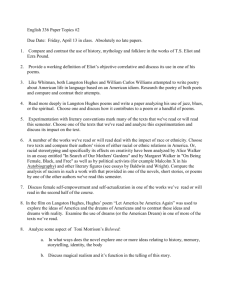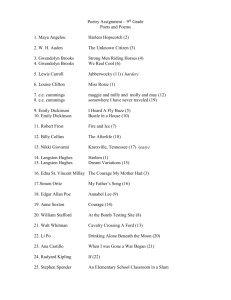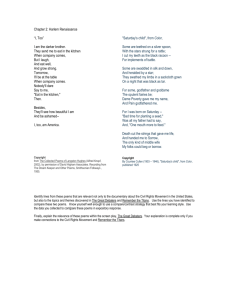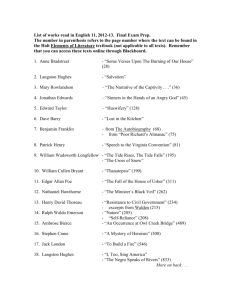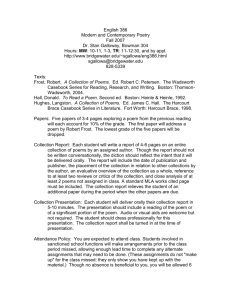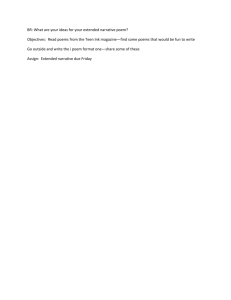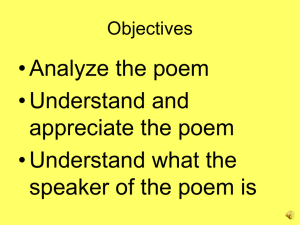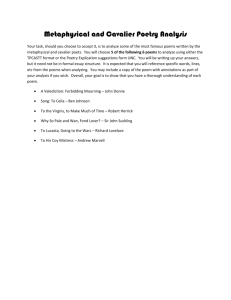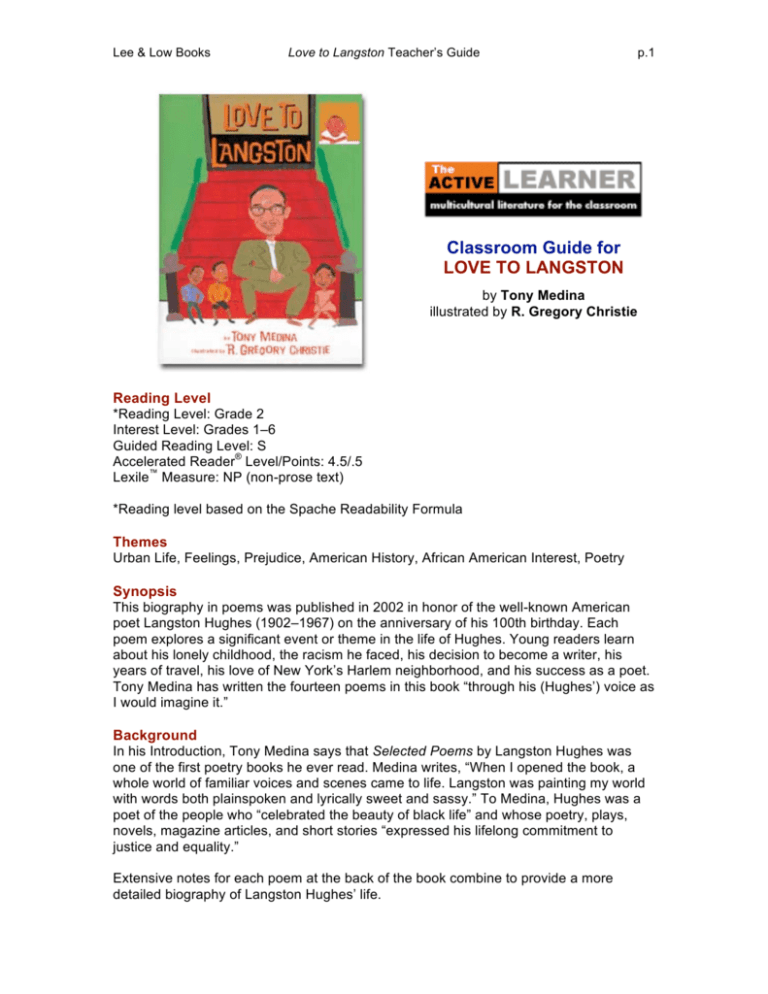
Lee & Low Books
Love to Langston Teacher’s Guide
p.1
Classroom Guide for
LOVE TO LANGSTON
by Tony Medina
illustrated by R. Gregory Christie
Reading Level
*Reading Level: Grade 2
Interest Level: Grades 1–6
Guided Reading Level: S
Accelerated Reader® Level/Points: 4.5/.5
Lexile™ Measure: NP (non-prose text)
*Reading level based on the Spache Readability Formula
Themes
Urban Life, Feelings, Prejudice, American History, African American Interest, Poetry
Synopsis
This biography in poems was published in 2002 in honor of the well-known American
poet Langston Hughes (1902–1967) on the anniversary of his 100th birthday. Each
poem explores a significant event or theme in the life of Hughes. Young readers learn
about his lonely childhood, the racism he faced, his decision to become a writer, his
years of travel, his love of New York’s Harlem neighborhood, and his success as a poet.
Tony Medina has written the fourteen poems in this book “through his (Hughes’) voice as
I would imagine it.”
Background
In his Introduction, Tony Medina says that Selected Poems by Langston Hughes was
one of the first poetry books he ever read. Medina writes, “When I opened the book, a
whole world of familiar voices and scenes came to life. Langston was painting my world
with words both plainspoken and lyrically sweet and sassy.” To Medina, Hughes was a
poet of the people who “celebrated the beauty of black life” and whose poetry, plays,
novels, magazine articles, and short stories “expressed his lifelong commitment to
justice and equality.”
Extensive notes for each poem at the back of the book combine to provide a more
detailed biography of Langston Hughes’ life.
Lee & Low Books
Love to Langston Teacher’s Guide
p.2
Teacher Tip
You may want to feature this book as part of your celebration of Black History Month in
February.
BEFORE READING
Prereading Focus Questions
Before introducing the book, share the background information with students. Then you
may wish to explore one or more of the following questions with them.
1. How would you honor someone you thought was really special?
2. Who is your favorite writer? Has that writer influenced you in some way? How?
3. What kinds of poetry do you enjoy? What is your favorite poem? Why do you like
it?
4. How do you show what you are feeling or thinking? Do you ever express yourself
through art, stories, dance, or poems? How do these forms of expression help
you communicate with others?
5. When something is unjust, what could you say or do about it?
Exploring the Book
Display the front cover of the book and read the title aloud. Ask students why they think
the author chose this title.
Discuss the front cover illustration. Invite students to comment on it and talk about who
is shown, where it might be, and why the illustrator chose this scene.
Show the photograph on the back cover and explain that it shows Langston Hughes, a
well-known poet, signing autographs for young people.
Invite students to leaf through the book. Draw attention to the inside jacket blurb,
introduction by Tony Medina, the two dedications, and the notes at the back of the book.
Plan to share these notes with students before or after they read the book.
Point out the titles of the poems and remind students to use these as they read to gain
meaning.
Setting a Purpose for Reading
Have students read to find out about the life and work of Langston Hughes.
Review with students that poems can take many forms and that not all poems rhyme.
Point out that poets use words in different and unique ways to share their messages and
feelings. Tell students they will be able to learn more about some of the ways that poets
present ideas from this book.
Discuss with students some of the other things they anticipate learning from this book
based on their observations so far.
Lee & Low Books
Love to Langston Teacher’s Guide
p.3
Teacher Tip
Some of the poems use nonstandard English. Explain beforehand to students that poets
often use what is called “poetic license” to achieve a certain effect or feeling, as the
author does in this book. Point out that poets sometimes do not use capital letters or
punctuation for the same reason.
Vocabulary
Explain that Harlem is a neighborhood in New York City. Then write the following words
on the chalkboard. Tell students that the words are all related to Harlem, especially
during the period of the Harlem Renaissance (the early decades of the twentieth
century) when Langston Hughes lived in Harlem. Have students look up the words in a
dictionary and record their dictionary meanings. Then have students refer to the poems
and other sources to figure out the particular meanings of the words relating to Harlem.
blues
strife
urban
soul
community
spiritual
boulevard
blackness
stride
pride
nightclub
concrete
cabaret
jazz
bruised
AFTER READING ACTIVITIES
Discussion Questions
After students have read the book, use these or similar questions to generate
discussion, review comprehension, and deepen students’ understanding of the poems
and Langston Hughes. Encourage students to refer back to the text and illustrations to
support their responses.
1. Who is the speaker in these poems? What makes you think so?
2. How is the poem “Little Boy Blues” like the Mother Goose rhyme “Little Boy
Blue”?
3. In “Grandma’s Stories,” why does the grandmother tell these tales?
4. How do both the teacher and mother act in “First Grade”? Why does each act
that way?
5. What is the Jim Crow Row? How do the black students feel about it? What do
they do?
6. In the poem “Libraries,” what makes these places special?
7. What is the speaker referring to in the last verse of “In High School”?
8. What is the problem between father and son in “I Do Not Like My Father Much”?
9. Why does the speaker throw books overboard in “Leaving Harlem for Africa”?
10. In “All My Life,” what does the speaker learn through his travels?
Lee & Low Books
Love to Langston Teacher’s Guide
p.4
11. Read “Harlem Is the Capital of My World.” Why is Harlem so important to the
speaker?
12. How do jazz and the blues affect the speaker in “Jazz Makes Me Sing”?
13. What does the speaker think words are for in “Poetry Means the World to Me”?
14. How do the oranges affect the speaker in “A Bag of Oranges”?
15. In “Sometimes Life Ain’t Always a Hoot,” how does the speaker view life?
Literature Circles*
If you are using literature circles during reading time, students might find the
following suggestions helpful in focusing on the different roles of the group members.
•
•
•
•
•
•
The Questioner might use questions similar to those in the Discussion Questions
Section.
The Passage Locator might look for lines in the poems that express the speaker’s
feelings.
The Illustrator might draw pictures showing his or her personal interpretations of
one or more of the poems, or choose to highlight parts of the poems other than those
the illustrator showed.
The Connector might find and share poems, songs, or stories by other writers of the
Harlem Renaissance.
The Summarizer might provide a brief summary of each poem for the group.
The Investigator might find poems written by Langston Hughes to share.
*There are many resource books available with more information about organizing and
implementing literature circles. Two such books you may wish to refer to are: Literature
Circles: Voice and Choice in the Student-Centered Classroom by Harvey Daniels
(Stenhouse, 1994) and Literature Circles Resource Guide by Bonnie Campbell Hill,
Katherine L. Schlick Noe, and Nancy J. Johnson (Christopher-Gordon, 2000).
Reader's Response
Use the following questions or similar ones to help students practice active reading and
personalize what they have read. Suggest that students respond in reader’s journals,
oral discussion, or drawings.
1. Reread the poems. Which ones suggest joy? Sadness? Pride? Other emotions?
What were the circumstances that elicited these feelings?
2. Which poem in the book is your favorite? Why?
3. What kind of person do you think Langston Hughes was? What parts of the
poems make you think so?
4. Reread the poem “Poetry Means the World to Me.” What means the world to
you? Why?
Lee & Low Books
Love to Langston Teacher’s Guide
p.5
Other Writing Activities
You may wish to have students participate in one or more of the following writing
activities. Set aside time for students to share and discuss their work.
1. Have students find out about the Jim Crow laws and write a report about them.
2. Introduce or review similes and metaphors. Explain that similes compare unlike
things and contain the words like or as. Give as an example this simile from
“Leaving Harlem for Africa”: I am letting go of my past like tears dropped from my
face one by one.” Explain that metaphors are comparisons made without the use
of like or as. Give as an example this metaphor from “Harlem Is the Capital of My
World”: Harlem is a bouquet of black roses. Then challenge students to write
similes and metaphors of their own.
3. Ask students to reread the poem “Libraries,” then write their own poems about
places that are special to them. Encourage students to include similes and or
metaphors in their poems.
ESLTeaching Strategies
These strategies might be helpful to use with students who are English language
learners or who are learning to speak English as a second language.
1. Have strong readers make tape recordings of the poems. ELL/ESL students can
follow along in the book as they listen to the poems.
2. Preteach key English vocabulary to help keep English language learners focused
on the poems. Post these essential words on the chalkboard.
3. Pair strong English speakers with ELL/ESL partners to help explain the poems
and word meanings as they read the poems together.
INTERDISCIPLINARY ACTIVITIES
To help students integrate their reading experiences with other curriculum areas, you
might try some of the following activities.
Social Studies
1. Use the poems and notes in Love to Langston, along with other resources, to
make a timeline of Langston Hughes’ life. In addition to the events covered in the
book, students might include his birth, death, college years, and significant
highlights in his writing career.
2. Use maps to help students locate the places mentioned in the poems. For
example, students might look for Lawrence, Kansas; Cleveland, Ohio; and
Topeka, Kansas, on a map of the United States. On a world map, have them
locate Africa and countries such as Russia, Poland, Italy, Hungary, Mexico, and
China. On a map of New York City, find Harlem, the East River, the Hudson
River, and St. Nicholas Avenue.
3. Several historical periods, people, and events are referred to in the poems. The
Underground Railroad and John Brown/Harpers Ferry are mentioned in
Lee & Low Books
Love to Langston Teacher’s Guide
p.6
“Grandma’s Stories.” Jim Crow laws are alluded to in “Jim Crow Row.” Duke
Ellington is mentioned and the Harlem Renaissance is alluded to in “Harlem Is
the Capital of My World.” Alice Walker is mentioned in “A Bag of Oranges.” Have
students work in pairs to research information about these items as well as
others alluded to in the poems, and encourage them to report their findings to the
class using whatever media they think are appropriate. Interested students might
also find out about Hughes’ home in Harlem, which is a historical landmark, and
the Langston Hughes Community Library and Cultural Center in Queens, New
York.
Language Arts
1. The poems in this book offer a good opportunity to teach students about poetic
devices. Introduce and discuss the following:
• Repetition: Have students note the repeating lines in “Little Boy Blues.” Ask
them to find other examples of repetition in the book, such as in “First Grade.”
• Onomatopoeia: Have students identify the words in “Jazz Makes Me Sing” that
represent the music.
• Personification: Ask students to find the lines in “Leaving Harlem for Africa”
that suggest the sea is a live creature.
• Alliteration: Direct students to the last lines of “Sometimes Life Ain’t Always a
Hoot.”
• Rhythm: Have students read the last verse of “In High School” aloud to hear
the rhythm.
2. Set up a poetry corner in your classroom. Include books of poems and displays
of the work of Langston Hughes and Alice Walker. Also place an empty notebook
in the area and encourage students to add their own poems.
Music
Play selections of blues and jazz music for the class. Introduce students to the work of
James Hubert “Eubie” Blake, Bessie Smith, Louis “Satchmo” Armstrong, Fletcher
Henderson, W. C. Handy, and Edward Kennedy “Duke” Ellington. Encourage students to
talk about how they respond to the various pieces and how they make them feel.
ABOUT THE AUTHOR AND ILLUSTRATOR
Tony Medina grew up in the projects in the South Bronx of New York City. He
graduated from Baruch College with a B.A. in literature, taught English at Long Island
University, and then went on to earn masters and doctorate degrees. Of Black Puerto
Rican descent, Medina was chosen by Writer’s Digest as one of the top ten poets to
watch in the new millennium. In addition to LOVE TO LANGSTON, Medina has written
DESHAWN DAYS and CHRISTMAS MAKES ME THINK, and contributed to the poetry
collection LOVE TO MAMÁ: A TRIBUTE TO MOTHERS. As an advocate for literacy
among today’s youth, Medina emphasizes not only the importance of being able to read,
but of loving to read. Medina has also written extensively for adult audiences, including
four poetry collections.
ABOUT THE ILLUSTRATOR
R. Gregory Christie is a three-time winner of the Coretta Scott King Illustrator Award
Honor for his books THE PALM OF MY HEART and BROTHERS IN HOPE, published
by Lee & Low Books, and ONLY PASSING THROUGH. He was born and raised in New
Lee & Low Books
Love to Langston Teacher’s Guide
p.7
Jersey and received his fine arts degree from the School of Visual Arts in New York City.
Christie’s artwork has appeared in numerous commercial publications, including The
New York Times, the Village Voice, The New Yorker, Parenting magazine, and on many
CD album covers. Other books he has illustrated for Lee & Low include RICHARD
WRIGHT AND THE LIBRARY CARD and DESHAWN DAYS.
LOVE TO LANGSTON received starred reviews from School Library Journal and Kirkus
Reviews, as well as many other awards and honors. These include:
• Best Books, School Library Journal
• Notable Children’s Book in the English Language Arts, NCTE
• 100 Titles for Reading and Sharing, New York Public Library
• Bank Street Bookstore Bestseller List
• Original Art Show, Society of Illustrators
• Chapman Award, Best Classroom Read Aloud, PlanetEsme.com
Resources on the Web
For reviews, awards for Love to Langston visit:
http://www.leeandlow.com/books/lansgston.html
To view the electronic version the Love to Langston Active Reader Classroom
Guide go to: http://www.leeandlow.com/teachers/guide52.html
View other Active Reader Classroom Guides at:
http://www.leeandlow.com/teachers
Book Information
$7.95 paperback
978-1-58430-283-4
$17.95 hardcover
ISBN 978-1-58430-041-0
40 pages, 81/8 x 10 3/4
Interest Level: Grades 2-6
Reading Level: Grade 2
(Reading level based on the Spache Readability Formula)
Themes: Biography (Langston Hughes), African American, interest, History, Poetry,
Occupations
Accelerated Reader® Level/Points: 4.5/.5
Lexile Measure®: NP
Scholastic Reading Counts!™: 3.7
Order Information
On the Web:
http://www.leeandlow.com/order (general order information)
http://www.leeandlow.com/books/langston0.html (individual secure on-line ordering
options)
Lee & Low Books
Love to Langston Teacher’s Guide
By Phone:
212-779-4400 ext. 25
212-683-3591 fax
By Mail:
Lee & Low Books, 95 Madison Avenue, NY NY 10016
Copyright © 1997-2007 The Active Learner
Lee & Low Books, all rights reserved.
For questions, comments and/or more information
please contact us at info@leeandlow.com
p.8

